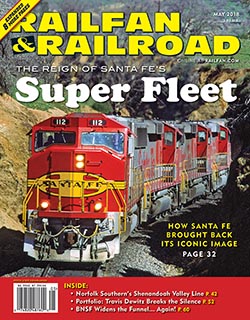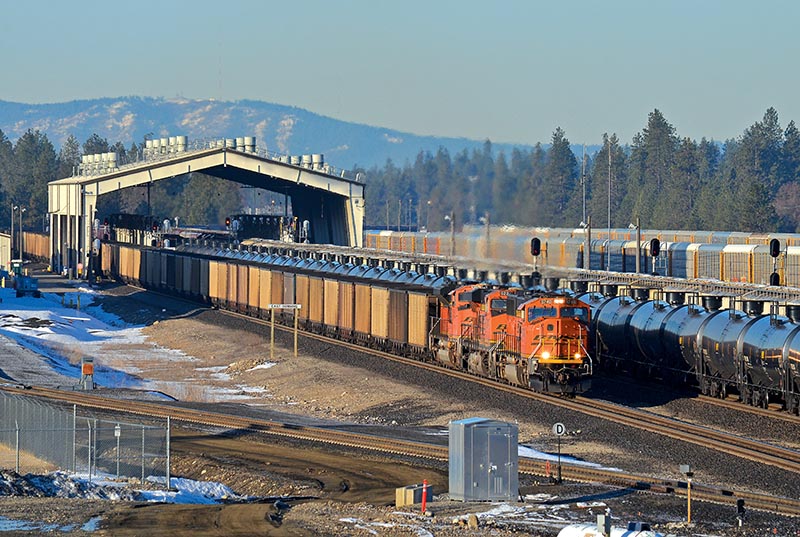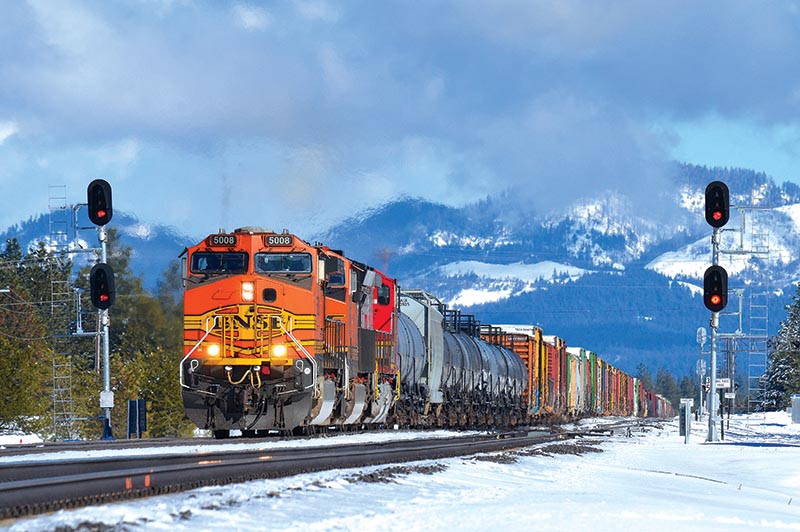 By Bruce Kelly/photos by the author
By Bruce Kelly/photos by the author
They don’t call it “the Funnel” for nothing. In the years following the 1970 creation of Burlington Northern, the former Great Northern mainline between Spokane, Wash., and Sandpoint, Idaho, suffered a gradual demise that left two separate branchlines in place. One section is now operated by shortline Pend Oreille Valley Railroad (POVA) between Newport, Wash., and Dover, Idaho, with POVA and Union Pacific sharing the last few miles between Dover and North Sandpoint. The other section is part of BNSF’s Kettle Falls Subdivision reaching north from Spokane toward Chewelah, Wash.
After new track connections were completed in 1972, BN began consolidating through traffic between Spokane and Sandpoint onto its former Northern Pacific line, creating the Funnel. At first, this mostly single-tracked route coped reasonably well under the combined train flow of the former GN; NP; and Spokane, Portland & Seattle lines funneling into Spokane from the west, and the GN and NP lines converging on Sandpoint from the east.

In 1972, BN laid six tracks at Hauser, Idaho, to replace some of the storage capacity that had been lost in Spokane due to post-merger yard reductions. Hauser was intended to become a sprawling 76-track classification yard, but wavering economics and BN’s investment in big-ticket projects elsewhere on the system stunted Hauser’s growth over the next quarter-century to no more than a dozen yard tracks.
During the 1980s and early ’90s, the Funnel started choking under seasonal increases of export grain and intermodal, as well as other traffic, and even a slight influx of coal bound for either Northwest powerplants or export through Roberts Bank, B.C. In 1982, BN lengthened the siding at Algoma, Idaho, into a 6.6-mile stretch of dual mainline. Minor additions to trackage were also made at Hauser Yard, at Yardley/Parkwater terminal in Spokane, and elsewhere along the Funnel. But it wasn’t until BN joined forces with Santa Fe Railway in the mid-1990s that any serious effort to widen the Funnel was begun.
When Railfan & Railroad last visited the Funnel in the July 1999 issue, the dust had recently settled on major projects that added much-needed capacity to this often-congested segment of BNSF’s Northern Corridor. Performed during 1997-98, those projects introduced new track and linked up existing sidings to produce three new segments of double-tracked mainline: Otis Orchards, Wash., to Rathdrum, Idaho (14.5 miles); Athol to Cocolalla, Idaho, (15 miles); and West Algoma to East Algoma, Idaho, (9 miles). That same period saw yard tracks extended and three new tracks added at Hauser Yard. BNSF then introduced a logistical improvement to Funnel operations in 2004 with its run-through refueling facility at Hauser…
 Read the rest of this feature in the May 2018 issue of Railfan & Railroad
Read the rest of this feature in the May 2018 issue of Railfan & Railroad



